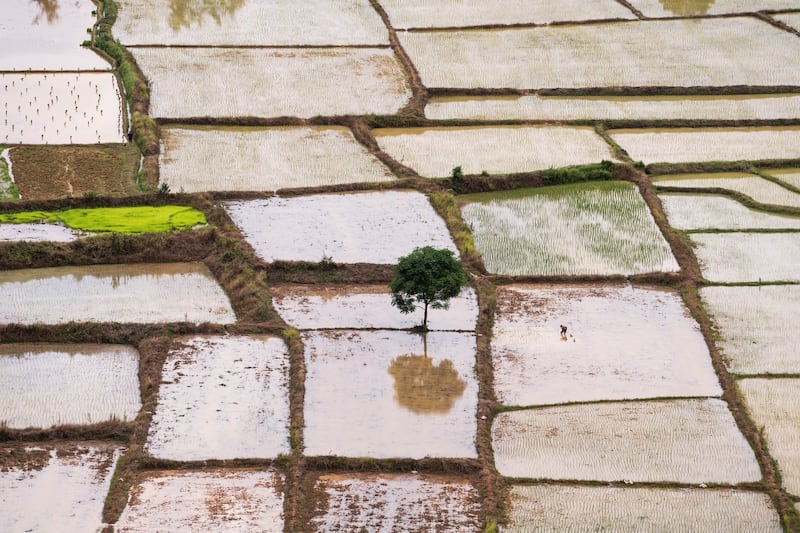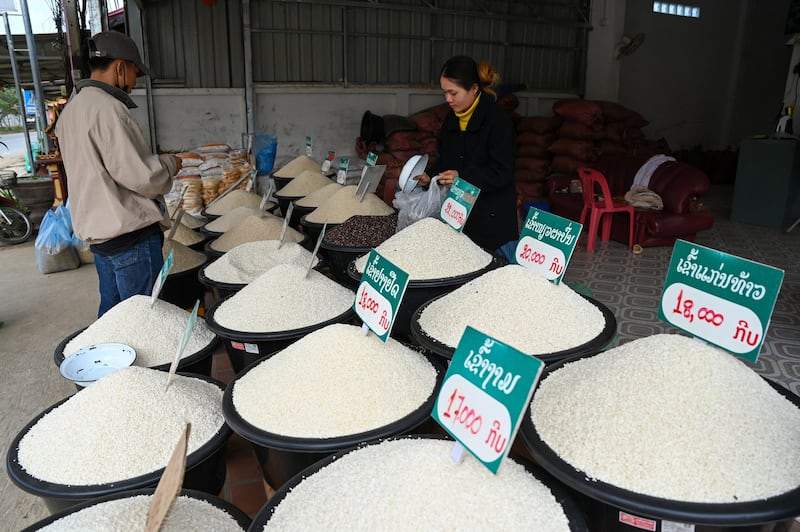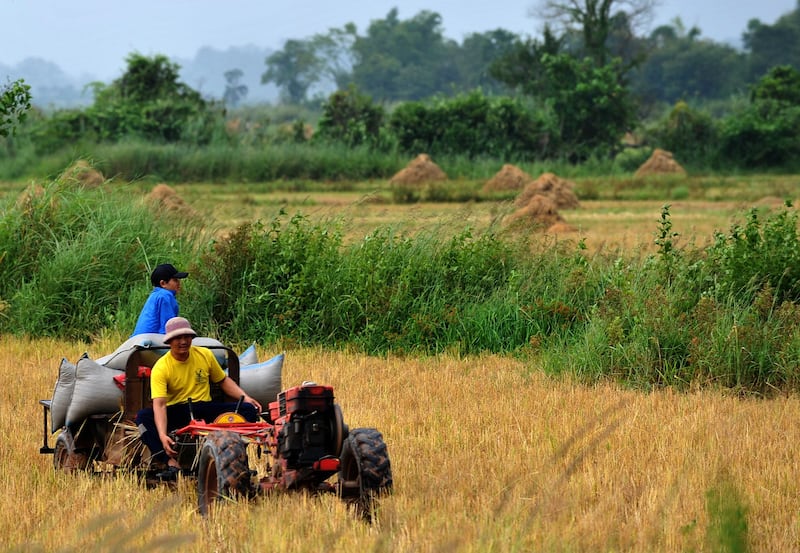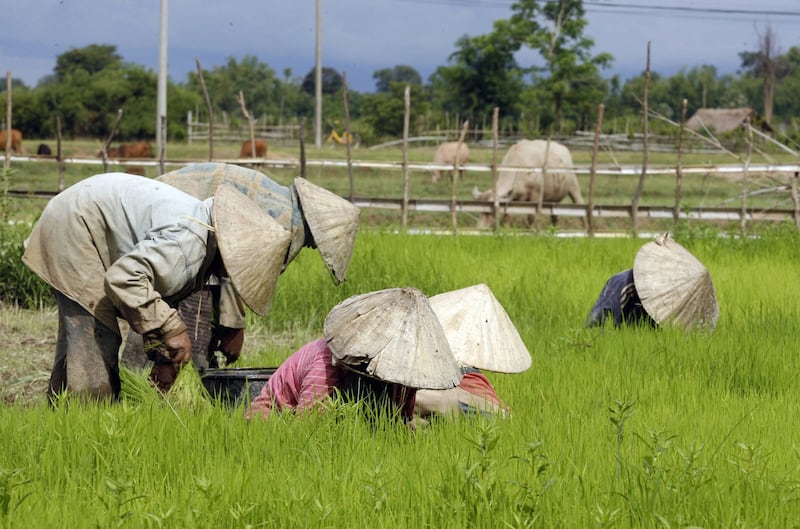Can Laos feed itself? The short answer: Yes. It can grow enough rice.
Per capita rice consumption is one of the highest in the world, at 206 kilograms (453 pounds) per person per year. The Lao Ministry of Agriculture and Forestry reckons the country can produce, at maximum, 3.7 million tons of rice annually. That’s around 510 kilograms (1,222 pounds) of rice per person.
However, when it comes to other foods, things become a little more complicated.
A few weeks ago, Prime Minister Sonexay Siphandone laid out new plans for self-sufficiency, the latest buzzword in Vientiane – and most Southeast Asian capitals. It's a very optimistic goal, but what else can the Lao government do?

RELATED STORIES
[ Weak governance, poor economy drive the hollowing out of LaosOpens in new window ]
[ Lao central bank governor removed amid economic crisisOpens in new window ]
[ China's dependency on potash imports could give tiny Laos rare leverageOpens in new window ]
[ Lao farmers worry about upcoming rice season as heat wave kills cropsOpens in new window ]
A monetary crisis since 2021 has kept inflation rates among the highest in Asia and seen the kip, the local currency, depreciate by as much as half against the U.S. dollar. Much of this crisis stems from Laos' dependency on imports -- mainly fuel -- and because it foreign currency reserves are almost depleted.
Sonexay wants Laos to be self-sufficient in finance and energy — an unlikely prospect. His third pillar is food.
A joint report by the Food and Agriculture Organization and the World Food Program warned that food insecurity affected more than a million people out of the 7.2 million population in 2022. The situation could have been worse.
Geography and transport
Since the economic crisis began in 2021, Laotians have responded in two ways: many have left for Thailand, where work is more plentiful and better paid, while others have returned to their family farms.
If Laos wants to industrialize and raise GDP per capita above the current $US 2,600, de-urbanization isn’t a long-term solution. And the policy ideas Vientiane is now talking about come up against structural problems.
First, consider geography. Most of Laos is mountainous and forested—there’s a reason why it has been a buffer region between the Thais, Burmese, and Vietnamese for centuries.
Never able to sustain a large population, Laos remains the least densely populated country in Southeast Asia, with 33 people per square kilometer (.38 square miles). Cambodia is the next least densely populated, with around 98 people per square kilometer (.38 square miles).

Only Laos' southern panhandle and some northern provinces – chiefly Xayaburi – are suitable for agriculture. The country has just 0.16 hectares (0.4 acres)of arable land per person, below the world average and well below what Thailand, Cambodia, and Myanmar have.
Geography and poor government management create the second problem: transport. For centuries, because the terrain made it difficult to move around, farms were small, serving only the immediate vicinity.
That remains so today, with four out of every five people still engaged in low-productivity, smallholder rice cultivation.
This prevented the formation of larger farms, meaning not enough capital was generated for private-funded infrastructure works, namely roads or railways. Moreover, the Mekong River flows along the Thai-Lao border, so it has never been feasible to ship food by waterway from the hinterland to population centers.
Selling to China
In more recent decades, the Lao government has barely invested in rural infrastructure. Only 12 percent of the cultivated rice area is irrigated, so the remainder can only be planted once a year during the rainy season. Irrigation would allow for two harvests a year.
By 2019, it was cheaper to import rice than grow it domestically, primarily due to transport costs. In 2022, Laos exported $US44 million worth of rice but imported $US 29 million worth.
Laos needs more capital for farmers to expand, irrigate, and diversify, and more investment to build roads or rail networks in the hinterland. But Laos is far less self-sufficient in capital than in anything else. The national debt is now around 130 percent of GDP.
The Lao state simply cannot afford to finance these projects itself. Vientiane must instead rely on external capital. Indeed, massive Chinese investment has recently flooded into Laos, but this creates two big problems.

Chinese firms invest in agricultural production in Laos to grow products for export to China, where prices are higher and food insecurity is a more pressing issue.
Why would Chinese firms invest hundreds of millions of dollars in building roads in, say, Phongsaly Province, the least accessible region, when they can lease Laos’ most fertile farms in regions like Xayaburi and Vientiane provinces, which already have great transport links to China?
There are now excellent transport links from Laos to China, like the Vientiane-Kunming railway. This has made it easier for farmers to sell their produce in China than within Laos.
Because of this export potential, many farms, including the most productive ones in the more arable provinces, have shifted to cash crops, mainly cassava. In January alone, Laos exported $98 million worth of cassava, making it the second-largest export after energy.
Rising fertilizer imports
Yet, because Laos’ soil is so poor, tons of artificial fertilizers and pesticides need to be dumped on it to achieve even minimum production standards.
Until recently, Laos used barely any artificial fertilizers. In 2010, per hectare of land, Laos used less than a tenth of what Thailand used. Now, it uses about half. Laos now uses more fertilizers per hectare than Cambodia, which produces far more food— around 2 to 3 times more rice per year.
Phosphate fertilizer use per hectare of cropland rose from 2.4 kg in 2000 to around 3.2 kg in 2010. But it spiked to 18.4 kg by 2021, overtaking the amount used in Cambodia and Thailand. Nitrogen fertilizer use almost doubled between 2017 and 2021.
Except for potash — of which Laos might have some of the world’s largest reserves — Laos has to import the other main types of artificial fertilizers.

If Laos wants to expand production of cash crops for export, which the government does, fertilizer use will have to increase even more.
This is not great for the environment, but it will be especially problematic if the international fertilizer market becomes more chaotic, which is expected. Moreover, an increased reliance on imported fertilizer hardly boosts self-sufficiency.
Any policy Vientiane thinks it could implement will run up against this main problem: The agricultural sector is now incentivized to export. This will result in more cash crops at the expense of staples, and ever-increasing imports of fertilizers.
With Laos’ ability to feed itself becoming ever more dependent on international markets, the main concern for self-sufficiency should be how much more reliant the country becomes on imports of food inputs. Without fertilizer, food output plummets.
David Hutt is a research fellow at the Central European Institute of Asian Studies (CEIAS) and the Southeast Asia Columnist at the Diplomat. He writes the Watching Europe In Southeast Asia newsletter. The views expressed here are his own and do not reflect the position of RFA.
